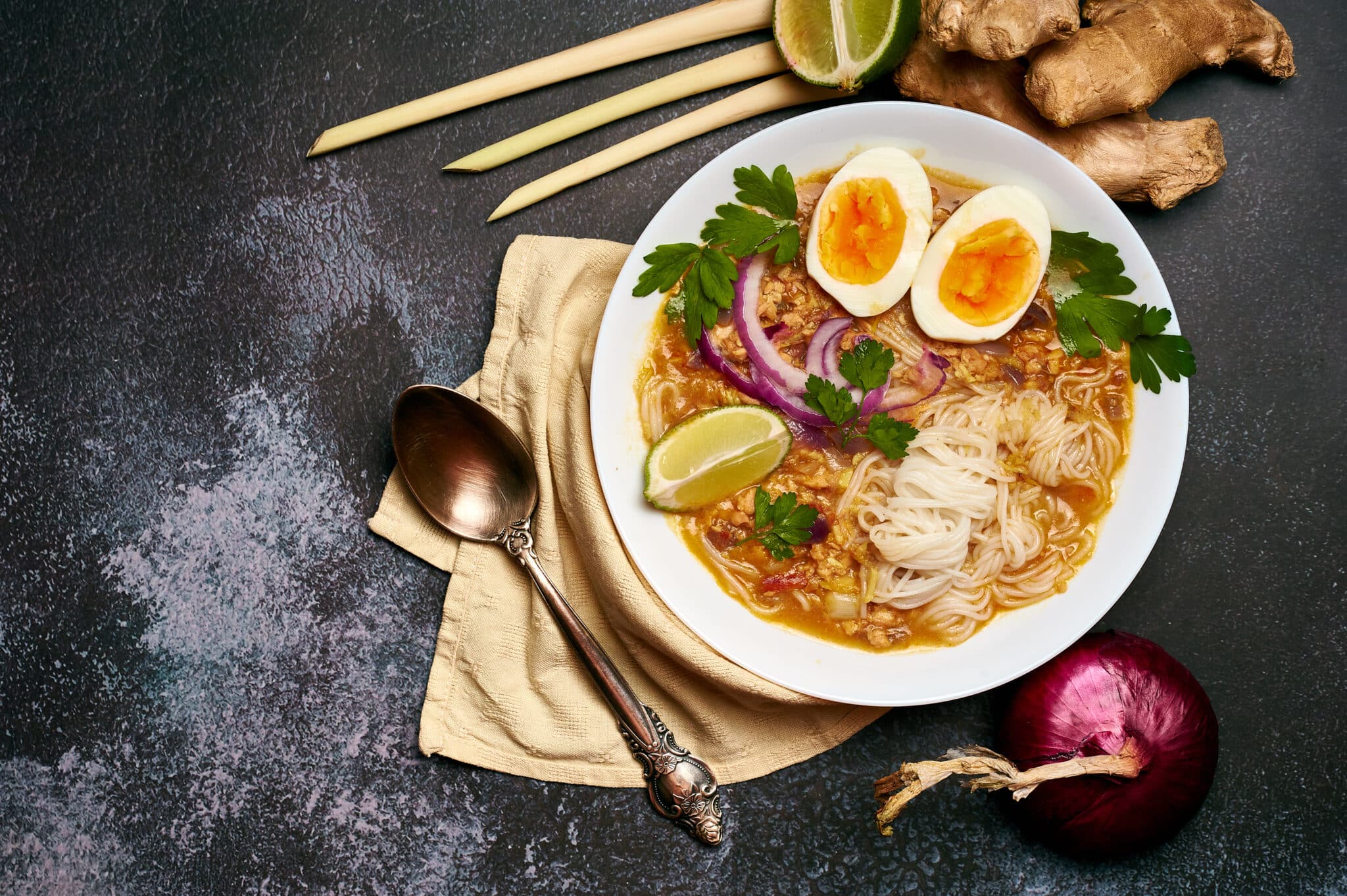
Mohinga, a cherished delicacy in Myanmar, is frequently celebrated as the nation’s signature dish.This savory fish soup served over rice noodles is a staple in Burmese cuisine and holds a special place in the hearts of locals and tourists alike.
Even though this dish is not well-known outside of this Asian country, you can find it everywhere in Myanmar. From street stalls to upscale restaurants. Furthermore, despite traditionally being a breakfast dish, it is so beloved that it is now enjoyed at any time of the day.
Learn more about this dish, from its fascinating history to how to prepare it with this guide created by our Remitly team.
The Origins of Mohinga
The origins of mohinga are shrouded in mystery. Some food historians believe it originated from coastal regions due to its fish-based broth. Others argue that it was born out of necessity, using readily available ingredients like catfish and rice noodles.
What we know for sure is that people in Myanmar have been savoring this dish for centuries. Historians emphasize that the earliest mentions of this delicacy can be discovered in poems that date back to the Konbaung dynasty, the final ruling dynasty in Myanmar from 1752 to 1885.
Mohinga has evolved to become an integral part of Burmese culture. People appreciate its rich flavors and comforting warmth, making it a favorite choice for everyday meals or special occasions.
Ingredients and Preparation
Mohinga’s main components are rice noodles and a hearty fish broth. The broth is typically made from catfish simmered with lemongrass, ginger, garlic, onions, and banana stem. This mixture creates a robust flavor profile that’s both tangy and savory. The soup is then poured over thin rice noodles. Toppings vary but often include hard-boiled eggs, fried split-peas, coriander leaves, lime wedges, chili flakes or fish sauce for added depth and complexity.
Mohinga has various regional variations, such as more plantain stem in Mandalay or spiciness with added chili in Rakhine. Additionally, it plays an important role in festivities. During Thingyan, the Water Festival of the Burmese New Year, serving Mohinga is a traditional practice that highlights its cultural significance in Burmese society.
A Simple Mohinga Recipe
Mohinga is not a very common dish outside of Myanmar, but you can prepare it at home. Here’s a basic recipe to start your culinary adventure.
Ingredients:
- 500g catfish fillets
- 1 stalk lemongrass, bruised
- 2 cloves garlic, minced
- 1 onion, chopped
- 1 thumb-sized piece of ginger, grated
- 2 tablespoons fish sauce
- 1 teaspoon turmeric powder
- Salt to taste
- Rice noodles
- Hard-boiled eggs (optional)
- Fried split-peas (optional)
- Coriander leaves for garnish
Instructions:
- In a large pot, add the catfish fillets and enough water to cover them. Bring to a boil then reduce heat and simmer until the fish is cooked.
- Remove the fish from the pot but keep the broth. Once cool enough to handle, flake the fish into small pieces.
- In another pot, sauté onions until translucent. Add garlic and ginger and cook until fragrant.
- Add turmeric powder and stir well.
- Pour in the reserved broth along with lemongrass stalk and bring to a boil.
- Lower heat then add flaked fish and fish sauce.
- Simmer for about an hour or until the flavors blend well.
- Cook rice noodles according to package instructions then drain well.
- To serve, place some noodles in a bowl then ladle over some soup ensuring there are equal parts of broth and fish flakes.
- Top with hard-boiled eggs or fried split-peas if desired then garnish with coriander leaves.
Challenges and Sustainability of Mohinga Production
Despite its popularity, producing mohinga faces several challenges. Overfishing threatens the availability of catfish while climate change impacts rice cultivation.
Efforts to address these issues are underway.
The Cuisine of Myanmar
Burmese cuisine is as diverse as its people – reflecting influences from neighboring countries like India, China, Thailand while maintaining its unique flavors.
Staple Ingredients
Rice is the cornerstone of Burmese cuisine. People often serve it with a variety of side dishes, including curries, salads, and soups. People also commonly use fish sauce and ngapi, a fermented fish paste, to enhance the depth and umami flavors of dishes.
Popular Dishes
Aside from mohinga, other popular dishes include tea leaf salad (lahpet thoke), Shan-style tofu noodles (shan khauk swe), and Burmese-style curry. These dishes showcase the range of flavors in Burmese cuisine – from tangy and savory to spicy and aromatic.
Street Food Culture
Street food plays a significant role in Myanmar’s culinary scene. From skewered meats to sweet treats like shwe yin aye (coconut jelly dessert), there’s something for everyone on the streets of Myanmar.
Regional Variations
Just as mohinga varies across regions, so does the rest of Burmese cuisine. Coastal areas favor seafood while inland regions lean towards meat and poultry. Regardless of these differences, though, one thing remains consistent – the love for good food that brings people together.
Visit the homepage, download our app, or check out our Help Center to get started.